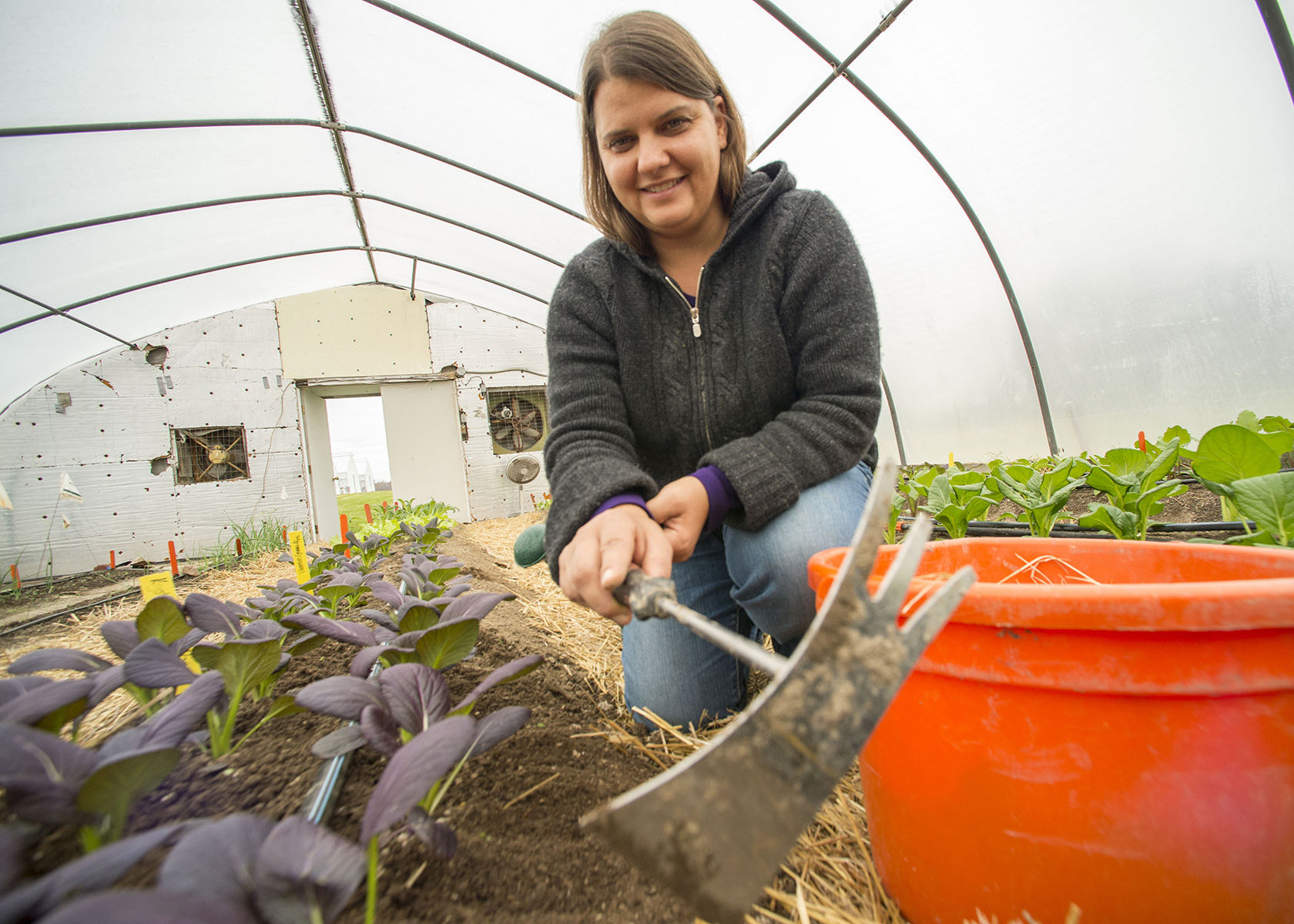
April Vigardt, a researcher with the Department of Plant, Soil and Agricultural Systems at SIU, brought a wide variety of Asian greens to the University Farms’ Sustainability Center as part of a specialty crops grant from the Illinois Department of Agriculture. Some greens are field grown and some, as shown here, she and her student crew grow in a high tunnel facility. Vigardt is focused on growing the greens, monitoring growth time, suitability for the Southern Illinois area, harvest and yield, among other factors. Other researchers on the project are focusing on introducing the greens to a new market and on ascertaining the nutritive value of the greens. (Photo by Russell Bailey)
December 01, 2015
Researchers study benefits of ‘Asian greens’
CARBONDALE, Ill. – “Asian greens” are becoming fashionable. Often tastier and hardier than the lettuce, cabbage and spinach of traditional American fare, Asian greens are finding their way into food shows, culinary magazines, gourmet and ethnic restaurants – and the University Housing dining halls at Southern Illinois University Carbondale.
April Vigardt, a researcher with the College of Agricultural Sciences, is taking advantage of the current trend favoring local foods, healthy foods and exotic foods to promote all three at once by growing several varieties of Asian greens at the Center for Sustainable Farming on campus.
Along with Sylvia Smith, associate professor in the Department of Animal Science, Food and Nutrition, and Ruplal Choudhary, associate professor in the Department of Plant, Soil and Agricultural Systems, Vigardt is using a grant from the Illinois Department of Agriculture’s specialty crop block grant program to learn more about how well these greens adapt to growing conditions in Southern Illinois – and how well the local palate adapts to them.
“I lived in Korea for a couple years,” Vigardt said, explaining how she first become familiar with different varieties of greens. “Even there at that time it wasn’t common to see a great many varieties of greens available. But not only does Korean cuisine use different greens, it uses them differently. Besides in salads and in cooking, Korean chefs use greens to wrap meat.”
Vigardt recognized some of the greens from her days in Korea when visiting farmers markets in Chicago. She also noticed exotic greens showing up in seed catalogs. Trying them out at the Sustainable Farms was a natural fit.
“These greens are easy for farmers to grow and quick to cook,” she said, citing some of the advantages of the exotic greens. “They are also very nutritious with a wide range of flavors, textures, shapes and colors.”
Vigardt is growing 18 warm season varieties and 17 cool season varieties to evaluate optimal growing seasons and production windows. So far, she’s determined that the plants are relatively hardy, tolerant of temperature variations and quick to mature. Plants grown from seeds are ready for transplant in three weeks, and often ready for harvest three to four weeks after that. In addition, some varieties are capable of multiple harvests.
Another plus? Not all the greens are “green,” some are red or purple, which, Vigardt pointed out, makes for a pretty garden, attractive meals and fun salads.
“I like the Tokyo bekana,” Vigardt said. “I enjoy some of the pac choi types as well, they are mild tasting. I like the spicier Komatsuna and the purple-veined Hon Tsai Tai. But actually I like them all together mixed up.”
The study isn’t just about growing the greens. It’s also about how best to introduce exotic greens to potential customers, to figure out what prompts a person to buy an unfamiliar green.
That’s where Smith comes in. She and Chef Bill Connors from residence hall dining have hosted cooking demonstrations at farmers markets in Carbondale using a combination of the greens. The demonstrations thus far were well received. Smith gave interested parties recipes and samples of Tokyo bekana salad, and the group sold the greens at the market as a “baby mix” for salads and a “stir fry” mix for cooking.
Connors also used the greens both as a salad and sautéed with olive oil and garlic for a recent Brazilian-themed meal in a campus dining hall, and said the greens are offered as part of the kale mix for salads and as part of the “Oriental Noodle Bowl” dish served there. “They seem to go over well,” he said. “The greens are spicier and have a different flavor.”
Choudary and student researchers are handling the phytonutrient and antioxidant analysis of the investigation. Phytonutrients are health boosting qualities of food occurring naturally in plants that have particular health effects. For example, glucosinolates, a class of phytonutrient, appear in cruciferous (green leaf) vegetables, and give these vegetables their odor and flavor. Research suggests that glucosinolates are useful in slowing or stopping the development and growth of cancer.
Ultimately, Vigardt and the research team plan to make all of this information – planting, growth and harvest, seed information, nutritional value and recipes – available where they sell the greens.
